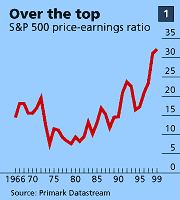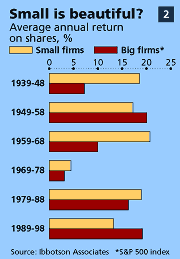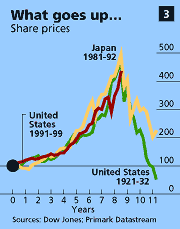![]()
Shared values
Dec 2nd 1999
From The Economist print edition
The penultimate
article in our series of schools briefs about finance considers how shares and
stockmarkets should be valued by investors
WHAT is the value of a share of a company? This innocent-seeming question is a source of endless difficulty and controversy. One answer is clear, of course: the value of a share is the price it commands in the stockmarket. That is true enough, but not very satisfying. Share prices move around erratically, often for no apparent reason. Fundamental value, one supposes, should be more stable. And prices are not in fact entirely random: they seem anchored, albeit elastically, to some underlying notion of worth. That is why, amid all the chaotic fluctuations, unexpectedly good news about company profits moves prices up, not down. Fundamental forces are at work—but how are they to be assessed? How are investors to measure the underlying value of a share?
Economic principles (and common sense) suggest that there must be two basic components. First, the flow of income that the owner of the share can expect to receive over time. (A share that will generate no income in any form at any time is fundamentally worthless.) Second, the rate at which this flow of income received in the future should be “discounted”, so that it can be compared in “present value” terms with income received today. All of the many different methods used by market professionals to value equities can be understood as attempts to gauge these two elements.
Shares would be much easier to value if investors received all their income from them in the form of dividends, and if they knew what those dividends would be year by year from now until the end of time. They would discount this infinitely long series of flows, using the interest rate available on some alternative asset with similar risk, add up the results, and thus calculate the present value of the income stream. This value would in turn be the share’s underlying worth.
But the world is more complicated than this. The first and biggest problem is immediately apparent: nobody knows, in fact, what the flow of future income from any share will be. So the first component of valuation calls for a forecast—and the scope for error and disagreement is already vast.
You would expect firms
that do well to pay bigger dividends in future, and firms that do badly to pay
smaller ones, or maybe to go out of business. Looking at the present level of
dividends and supposing that it will persist indefinitely is therefore not a
sound basis for valuation. Moreover, a growing number of firms do not pay
dividends at all. So a more plausible guide is earnings (that is, profits). If a
firm is profitable now, it has the means both to pay its owners a dividend and
to retain some resources for investment. Retained earnings allow the company to
grow, and provide the wherewithal for higher earnings and dividends in future.
Earnings, in other words, provide the means to pay income to shareholders not
just now but next year and the year after. Unlike dividends, they have a
forward-looking character.
That is why the most popular traditional measure of valuation looks at earnings in relation to the share’s price in the market. This can be done in two ways. First is the price/earnings ratio, probably the most quoted measure of valuation: the higher the p/e ratio, the more expensive a share is in relation to the firm’s earnings. Wall Street’s aggregate p/e ratio is currently more than 30—astonishingly expensive by historical standards (see chart 1).
|
|
|
 |
The other way of looking at it is to turn the ratio upside down, and to consider earnings divided by price. This is called the earnings yield. As a valuation measure, this is very natural and appealing. In effect, it shows current profit as a rate of return. Not all earnings will be paid out as dividends immediately, but to the extent they are not, the value of the firm can be expected to grow thanks to investment from retained earnings. This growth, in turn, will be reflected in a rising share price. So you can think of earnings yield as the engine that drives both dividends and capital gains, the two forms in which shareholders receive most of their income from their shares.
Because the earnings yield is a rate of return, it can be directly compared with other rates of return. Wall Street’s aggregate earnings yield is currently about 3%. Note that this is a real (after inflation) return. The rate of return on American index-linked government securities (also a real return) is roughly 4%. On this measure, then, American shares in the aggregate are paying a lower rate of return than a perfectly safe alternative investment. Given that shares are a riskier investment than index-linked liabilities of the American government, this is an extremely surprising state of affairs (and one that is the converse, of course, of the extraordinarily high p/e ratio mentioned a moment ago).
According to these traditional earnings-based measures, then, Wall Street is extremely “overvalued”. Is the market wrong—or is the valuation method wrong? The earnings measures are not without their drawbacks. Although they are somewhat forward-looking (because they allow for investment and growth), and although their historical record in predicting total returns on shares is excellent, they may nonetheless lead investors astray. If companies grow faster in future than in the past, for reasons over and above the investment of retained earnings, then actual earnings will grow faster as well, and the earnings yield will prove to have been too gloomy an indicator.
This is not to say that there is no limit on what that growth might be. Logic and accounting identities set some ceilings—a fact that some market optimists tend to forget. (Obviously, for instance, earnings cannot grow faster than the economy as a whole for ever, for the simple reason that earnings cannot account for more than 100% of the economy.) Nonetheless, if the world is undergoing a new industrial revolution, driven by computers and the Internet, as many suppose, it is possible that earnings will surge for some time yet above their historical norms.
The forecasting
problem is ultimately insoluble. However, some analysts have other reasons for
preferring alternative measures of shareholder income to measures based on
earnings. For instance, earnings is an accountant’s concept: a clever finance
man, it is said, can make a company’s earnings come out at whatever he likes.
Some analysts prefer measures less prone to manipulation, such as sales, or
“cashflow” (which comes in various shapes and sizes). Still others prefer to
look at the value of a firm’s physical assets (such as buildings and equipment).
None of these measures is perfect. The best course may be to weigh all of them.
When all is said and done, however, the amateur investor is well advised to look
hard, and think hard, about earnings yield.
But now comes another problem. Suppose the earnings yield accurately predicts the return to be expected on equities. What is the appropriate rate to compare it with? And in making the comparison, how much of a premium (if any) should the investor expect to receive in return for bearing the extra risk (if any) of holding equities? Thinking back to the two components of valuation, income and the discount rate, this new question boils down to asking whether the discount rate should include an allowance for risk.
Many recent arguments
about the level of Wall Street are really arguments about risk and the
appropriate size of the risk premium. A crucial idea here is diversification. It
makes sense for investors to diversify their holdings of shares, for two reasons.
First, some firms are hit by random occurrences that affect only themselves (eg,
the founder dies or a clever employee invents post-it notes). Second, even apart
from such specific shocks, different firms thrive in different circumstances, in
ways that are often predictable (eg, falling oil prices hurt Shell but help
Singapore Airlines). As a result of these tendencies, a big portfolio is less
risky than a single stock.
This means not only that all investors should diversify, but that the risk premium on individual stocks should take account of this widespread practice. So when determining an individual equity’s risk premium, the overall riskiness of its cash payouts is not important: what matters is how those payouts relate to the rest of the portfolio. In other words, the premium on an individual firm’s shares should be based in some way on their contribution to portfolio risk.
The famous Capital Asset Pricing Model (CAPM, pronounced cap-m) is built on this idea. It relates the risk of shares to the risk of the market as a whole, rather than to the shares’ specific risks. In this way the principles of diversification refine the way investors judge the risk of individual stocks. Using volatility as a proxy, they recognise that the risks of two stocks that bounce around a lot, but always do so in the opposite direction, net out to nil if they are mixed in one portfolio. So the volatility that matters to investors is only the residual riskiness that a stock brings to a portfolio (called “beta”, in the jargon). And it is this aspect of volatility that determines what the expected returns should be. Shares that offer higher expected returns for the risk that investors bear are deemed cheap.
The CAPM is not uncontroversial. Debate rages over whether it, or some other model, best captures the link between risk and return. The main problem is in how to measure volatility. Invariably, any estimates must be based on past returns. And by using those data, economists tacitly assume the future is going to resemble the past. Forecasts again.
Consider the view that shares are a great buy for long-term investors, because the short-term “risks” of holding them balance out over time. But this ignores the possibility that the volatility of the stockmarket as a whole might change. More importantly, it helps to remember that volatility is just a variable that economists have chosen to measure risk. For short-term investors, who buy and sell frequently, it is an excellent measure. But for long-term investors, what matters more is whether they will enjoy high returns over the next 30 years or so. And that depends on other risks, such as the prospects for productivity growth, wars, disease and demographic and technological trends.
To realise the benefits of diversification, portfolios should contain shares
that, on average, do not move in lock-step. But putting faith in historical
correlations to estimate this can pose problems. The long-term investor might
want to consider rather different things, such as the outlook for democracy in
Asia, the future of Russia or the effect of the Internet on established brands.
American and European stockmarkets, for example, tend to move together now. But
their value ten years from now could be very different, for reasons that have
nothing to do with today’s price gyrations.
Despite drawbacks with historical data, and some of the practical problems of measuring risk, the studies that economists have done paint an impressive picture of the way stockmarkets work. They suggest that most stockmarkets, especially in advanced economies, are extremely efficient at incorporating new information into share prices. This claim may seem fanciful to the average investor, who sees everyone around him trying to beat the market.
But economists do not define market efficiency in absolute terms. From its inception, the concept has been defined in terms of information. A market is efficient with respect to quarterly profit announcements, for example, if the implications of those announcements are immediately incorporated into share prices. If the effects of the announcements seeped into the price over a number of weeks, or even years, the market would not be efficient. Economists measure these effects through event studies, which capture the impact of such new information on the price of shares.
Over the past 25 years economists have published hundreds of such studies, examining the effects of mergers, R&D announcements, new product launches, changes in the boardroom, and just about everything else that investment gurus mention when hawking the latest hot stock. And overwhelmingly these studies tell the same story: you cannot beat the market, and you will make only your stockbroker rich by trying.
|
|
|
 |
These studies, of course, are limited by the measures of risk that financial economists use. The most obvious challenges to the market efficiency model involve a long-term tendency for some types of share to outperform others. For example, until the past decade, the shares of small companies consistently outperformed large ones even after adjusting for traditional measures of risk (see chart 2). The debate is whether such higher returns are due to additional risks that economists have not measured properly, or whether they represent profit opportunities that the market has failed to eliminate.
|
|
|
 |
Even if shares are priced correctly relative to each other, and perhaps relative to other obvious financial assets such as Treasury bonds, does that mean that the overall level of the market is correct? Consider the prospects for America’s stockmarket. At current prices, as noted earlier, the risk premium for the market as a whole (measured as the difference between the earnings yield and the riskless index-linked bond rate) is actually negative. Historically, economists estimate that the risk premium on American equities has been both positive and substantial, at around 6%.
Some economists believe that the equity risk premium may have been overestimated in the past. Market bulls have seized on this, and combined it with their own explanations of why the premium should be falling, to argue that it is much lower now. The lower the premium, the higher share prices can rationally rise. But it seems hard to justify a premium of zero, never mind one that is negative.
Are the bulls right? Many economists have doubts, but they are reluctant to question the market. Institutional investors, for their part, have a lot riding on continued strength in shares. And the man in the street—well, for now at least, he is running with the bulls.
|
|
|
|
|
Copyright © 2008 The Economist Newspaper and The Economist Group. All rights
reserved. |
|
|
|
|